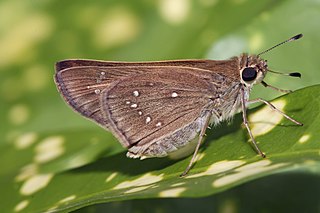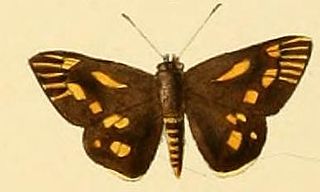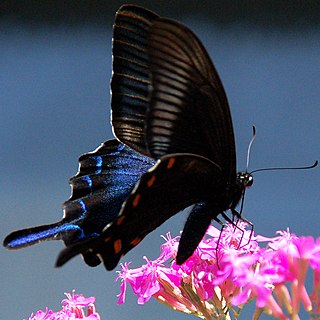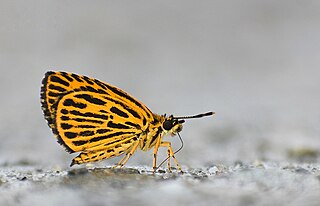
Skippers are a family of the Lepidoptera named the Hesperiidae. Being diurnal, they are generally called butterflies. They were previously placed in a separate superfamily, Hesperioidea; however, the most recent taxonomy places the family in the superfamily Papilionoidea, the butterflies. They are named for their quick, darting flight habits. Most have their antenna tips modified into narrow, hook-like projections. Moreover, skippers mostly have an absence of wing-coupling structure available in most moths. More than 3500 species of skippers are recognized, and they occur worldwide, but with the greatest diversity in the Neotropical regions of Central and South America.

Grass skippers or banded skippers are butterflies of the subfamily Hesperiinae, part of the skipper family, Hesperiidae. The subfamily was established by Pierre André Latreille in 1809.

Ampittia dioscorides, the common bush hopper or simply bush hopper, is a butterfly found in India, China, Indochina, Cambodia and on to Borneo, Sumatra and Java belonging to the family Hesperiidae.

Tajuria is an Indomalayan genus of butterflies in the family Lycaenidae.

Tongeia is a Palearctic genus of butterflies in the family Lycaenidae found in temperate East Asia. Most species are endemic to China and many species are recently described from China. The best known species is the more widely distributed Tongeia fischeri.
Platylesches ayresii, the peppered hopper, is a butterfly of the family Hesperiidae. It is found in bushveld in Botswana, western Transvaal, KwaZulu-Natal, Mozambique and Zimbabwe. The habitat consists of dry savanna and grassland.

Platylesches robustus, the robust hopper or large hopper, is a butterfly of the family Hesperiidae. It is found in Zululand, Eswatini, Transvaal, Mozambique and Zimbabwe. The habitat consists of moist, frost-free savanna and the transitional zone between forest and Guinea savanna.
Borbo fallax, the false swift, is a butterfly of the family Hesperiidae. It is found in tropical Africa. In South Africa it is found in Eswatini, coastal KwaZulu-Natal, northern Gauteng and the Limpopo Province and the extreme north-east of the North West Province. The habitat consists of coastal bush and moist savanna.

The Erionotini are a tribe in the Hesperiinae subfamily of skipper butterflies.

Ampittia capenas, the riverine ranger or African bush hopper, is a butterfly in the family Hesperiidae.
Ampittia sichunanensis is a butterfly in the family Hesperiidae. It was described by Z.G. Wang and Y. Niu in 2002. It is found in China (Eimashan).

Ampittia virgata is a butterfly in the family Hesperiidae. It was described by John Henry Leech in 1890. It is found in China and Taiwan. Its wingspan is 30–32 mm. Cell of forewing beneath yellow with a black streak in the centre.
Andronymus fontainei is a butterfly in the family Hesperiidae. It is found in the Democratic Republic of the Congo and is possibly endemic to the Albertine Rift.
Chondrolepis ducarmei is a butterfly in the family Hesperiidae. It is found in the Democratic Republic of the Congo and is endemic to the Albertine Rift. The habitat consists of submontane areas.
Chondrolepis uluguru is a butterfly in the family Hesperiidae. It is found in Tanzania. The habitat consists of submontane areas.

Caenides dacela, the common recluse, is a butterfly in the family Hesperiidae. All members of Caenides are within the geographical range that stretches from the Basse Casamance in Senegal to Uganda and Kenya, but generally does not penetrate much south of the Equator. It is found in Senegal, Guinea, Sierra Leone, Liberia, Ivory Coast, Ghana, Nigeria, Cameroon, Bioko, Gabon, the Republic of the Congo, the Central African Republic, Angola, the Democratic Republic of the Congo, Uganda, western Kenya, western Tanzania and northern Zambia. Amongst the genus Caenides, Caenides dacela is the most common and most widely distributed. The habitat consists of forests.

Achillides, the peacock swallowtails, are a subgenus within the genus Papilio containing 25 species.

Ochus subvittatus, the tiger hopper, is the only species in the monotypic moth genus Ochus of the family Hesperiidae. The genus was erected by Lionel de Nicéville in 1894. The species was first described by Frederic Moore in 1878. It is found in the Khasi Hills and Naga Hills of India, Myanmar, Thailand, Laos, Vietnam and Yunnan.











